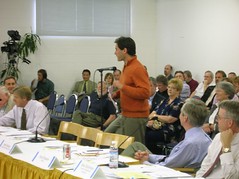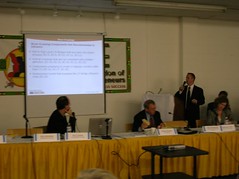It was a busy meeting for the Columbia River Task Force last night. Their task was to vote on the crossing and transit components to move forward to the next round of analysis. They didn’t get very far. Concerns were raised about the level of outreach in the public comment process (indeed, Portland Transport’s comments, submitted by the deadline on the comment cards handed out at the open houses, didn’t make it into the packet mailed to task force members – in fact, no comments submitted after the open houses were available to the task force before this decision making meeting) and other objections to task force process were raised.

BTA Policy Director (and Portland Transport contributor) Scott Bricker addresses the Columbia River Crossing task force |

The task force reviews crossing options |
It was a busy meeting for the Columbia River Task Force last night. Their task was to vote on the crossing and transit components to move forward to the next round of analysis. They didn’t get very far. Concerns were raised about the level of outreach in the public comment process (indeed, Portland Transport’s comments, submitted by the deadline on the comment cards handed out at the open houses, didn’t make it into the packet mailed to task force members – in fact, no comments submitted after the open houses were available to the task force before this decision making meeting) and other objections to task force process were raised.
The task force did make a couple of decisions. They narrowed the arterial bridge options to RC-23, the single option recommended by staff. The logic was that this option was sufficiently broad to allow a number of arterial configurations to be studied, but some task force members expressed concern that having a single arterial option would limit the number of non-freeway configurations that would be studied in later phases of the project.
They also eliminated all the ‘3rd corridor’ options, on the basis that they didn’t serve the project ‘Purpose and Need’. But before this vote, several Clark County representatives expressed the need to move forward new corridor options, and apparently the SW Washington Regional Transportation Council (RTC) is in the process of advancing a proposal separate from the CRC process.
The meeting was already 30 minutes over schedule when they adjourned, leaving the rest of the decisions to the next meeting.
6 responses to “CRC Task Force Has Trouble Crossing Decision Point”
Nice to have meet you there Chris. I spoke to someone heavily involved in Washington state projects afterwards and he wanted to make sure he shot down the idea of High Speed Rail in the BIA. Placing HSR in a tunnel option wouldn’t work because of the grade issues was his opinion. (How do HSR systems in Europe handle the Alps? Don’t the Europeans have to deal with grade issues? I need to look into this statement of his to confirm this point.) He put the price tag on a long tunnel for I5 and HSR at $3 Billion and he could very will be right (if his grade issue is true). That kind of cost isn’t good for us tunnel/HSR/I5 supporters.
I mentioned that HSR will never happen if the corridor goes over the Willamette River twice and this point was news to him. He basically saw my point. (I base this lack of knowledge about how Amtrak goes through Portland on his focus being on Washington engineering issues and having never taken Amtrak to Oregon or California.)
But then he said with the development already in North Portland along I5 there wasn’t any space for HSR. I grant him this. But if the states really wanted HSR they would find a way to make it happen at CRC and places North and South of the BIA during the next thirty years.
I would just like HSR to be in their vision for CRC, not built out now like they would like the ten lane bridge.
They are very, short sighted in my opinion. And I agree with you that the team is having trouble getting through the choices for many reasons (members are feeling left out, ignored, used, etc.).
Ray Whitford
Yea, Europe builds 50 km long tunnels.
http://www.alptransit.ch/pages/e/projekt/projekt.php
Sorry, here is the correct link of the 57 – km Gotthard Base Tunnel to be built in the Alps:
http://en.wikipedia.org/wiki/AlpTransit
Additionally, Switzerland uses the cog railroad for the really steep stuff:
http://en.wikipedia.org/wiki/Cog_railway
Note that this doesn’t work too well for High Speed Rail.
Ray,
I would like to know why you say that we cannot have high-speed rail if it has to cross the Willamette twice? I know this does slow it down; but would it not go fast enough in the long stretches? It seems that Vancouver would also have to move its Amtrak station to the new corridor that you propose. Could there be an express train stopping only at major cities? I know they would still get slowed down, but at least could cut out the stopping time.
I realy sympathize with your dream; it just seems that the whole package-to do this corridor properly– would in these days rank as major pork barrel spending. I never believed that the invasion of Iraq would be an appropriate allocation of US money. I always believed that the best thing was to strengthen a UN force to widen the inspections to include human rights abuse–even if we had to fund most of it. That cost might have been twenty billion.
But now that GWB is in the process of blowing a cool trillion in Iraq what are US taxpayers going to do? No matter who caused it, we now have a deficit. Besides if Central Eastside would greatly benefit from I-5 realignment how about throwing some other neighborhoods the benefits of federal dollars? CEID, and other I-5 supporters should work for a coalition that more neighborhoods can benefit from–not just the Central City. Its politics.
But then he said with the development already in North Portland along I5 there wasn’t any space for HSR
Sure there is. You just take a lane out of I5.